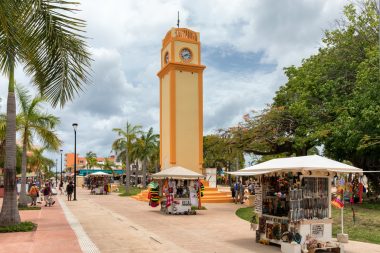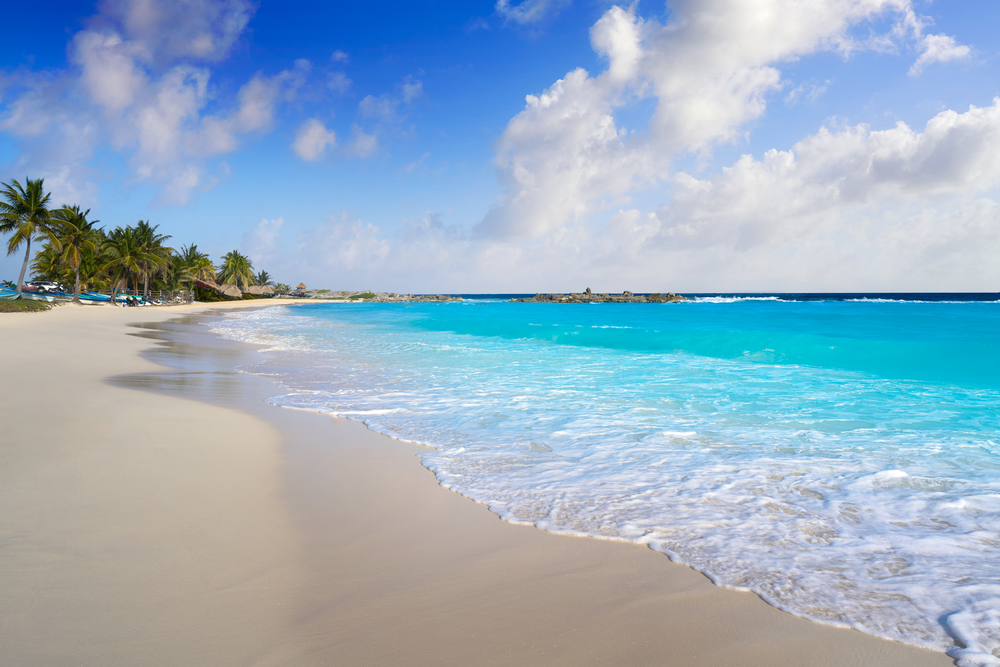Picturesque beaches and adventurous underwater landscapes make the island of Cozumel stand out as a diverse holiday highlight with endless possibilities.
Located just off the Yucatan Peninsula and 15.8 km from the Mexican mainland, Mexico’s third-largest island is located in the Caribbean Sea. Cozumel is known for its beautiful sandy beaches, tropical nature, pristine lagoons and breathtaking underwater landscapes, which also make the island a popular tourist destination.
Around Cozumel stretches the world’s second largest reef. The Belize Barrier Reef is home to particularly good diving opportunities and promises unforgettable diving and snorkeling experiences.
In addition, interesting transmissions from the Maya and some of their surviving buildings captivate not only visitors with archaeological interest.
Getting to Cozumel is possible by plane, ferry, and cruise ship. A large part of the tourism on the island comes from cruise tourism from the USA.
It’s not just vacationers who are drawn to Cozumel. Athletes also get their money’s worth here every year at the Ironman Mexico thriatlon event held in November.
The island has only a partially developed road network, which means that, for example, the north is only accessible to boats or off-road vehicles. Cozumel has large plains, which makes cycling a good idea. This is also a way to get to impassable places. You can move around the island even more relaxed with e-bikes or scooters.
The majority of the people who live on Cozumel live in the island’s capital, whose name is San Miguel de Cozumel.
The official language is Spanish, but about 20,000 of the inhabitants still speak Maya-Yucateco, the language of the indigenous people. In addition to about 10,000 immigrant Americans, many natives also speak English, as many residents of Cozumel work in the tourism industry and are therefore dependent on the language.
San Miguel de Cozumel

San Miguel de Cozumel is the only city and thus the capital of the island, which has 100,000 inhabitants.
The city center is located by the sea, not far from the ferry that connects to the Mexican mainland and receives ferries from Playa del Carmen as well as huge cruise ships worldwide.
San Miguel is also a tourist place with numerous restaurants, cafes and shops. Along the long waterfront promenade there are also numerous shops, restaurants and tour operators as well as shops for vehicle rental.
Among the most important sights are the Benito Juarez Park and the Clock Tower in the square de Benito Juarez.
In contrast to the old buildings and squares are numerous great street art works of art, which run like a red thread through the city and can be found in different places.
The paradisiacal nature of Cozumel
Outside of San Miguel de Cozumel, the picture is characterized exclusively by wild jungle and large farms and haciendas. The island has a species-rich and tropical flora and fauna and is particularly impressive for nature lovers.
Punta Sur
A natural paradise and the largest ecological reserve is Punta Sur in the south of the island. It has one of the most beautiful beaches and the mangrove landscape of Laguna Colombia invites you to go on boat tours, where you can spot exotic birds, raccoons, coatis and, if you’re lucky, crocodiles. The Faro Celarain is a lighthouse that promises a sensational view over the coast and lagoon. Near the lighthouse you can visit the Maritime Museum and the Sea Turtle Breeding Station.
Chankanaab
Chankanaab comes from the Mayan language, which means “little sea” and is a touristic water and eco park.
The center of the park is the Acuario Lagoon, where underwater caves lie and dolphins, manatees and sea turtles can be viewed. Furthermore, the park includes replicas of historical Mayan buildings, a botanical garden, a diving museum, restaurants and shops.
The Belize Barrier Reef and the beaches of Cozumel

The Mesoamerican reef system extends in the underwater world for twenty-two kilometers not far from the beaches of Cozumel. This is ideal for snorkeling and diving and encountering sea turtles, rays, dolphins and sharks in the wild.
The Palancar Reef in the southwest of the island is like an underwater mountain range with its numerous caves and holes.
Around the island there are beaches of different characteristics, but numerous with dream beach character. While in the west there are rather fine sandy beaches with crystal clear water, in the east the rough and wild ocean with strong currents is ideal for surfing. The rocky coves along the beaches are exceptional and offer great photo backdrops.
Playa el Cielo is known for its turquoise blue waters, making it one of the most beautiful places in the Caribbean. There is a particularly high occurrence of starfish there, sometimes in the hundreds. El Cielo is only accessible by boat.
The history of the Maya
Cozumel was considered a sacred island for the Maya and has archaeological sites such as San Gervasio and El Cedral. The most important building is San Gervasio, located in the middle of the island and used for worship. The building is not particularly imposing and also not comparable to other Mexican buildings of the Maya.
El Cedral is located in the south of the island and is the oldest Mayan building on Cozumel and already a ruin. This consists of a small house and a small church, which still has great religious significance for the inhabitants today.
The climate of Cozumel
| Month | Temp. min (°C) | Temp. max (°C) | Precipitation (mm) | Hours | Humidity (%) |
|---|---|---|---|---|---|
| January | 18 | 28 | 104 | 7 | 77 |
| February | 18 | 29 | 54 | 8 | 75 |
| March | 20 | 30 | 34 | 8 | 73 |
| April | 21 | 31 | 44 | 9 | 71 |
| May | 23 | 32 | 96 | 8 | 75 |
| June | 24 | 32 | 183 | 7 | 78 |
| July | 25 | 33 | 137 | 8 | 77 |
| August | 25 | 33 | 151 | 8 | 76 |
| September | 24 | 32 | 218 | 7 | 80 |
| October | 23 | 31 | 222 | 7 | 79 |
| November | 21 | 29 | 117 | 7 | 78 |
| December | 19 | 28 | 102 | 7 | 77 |


